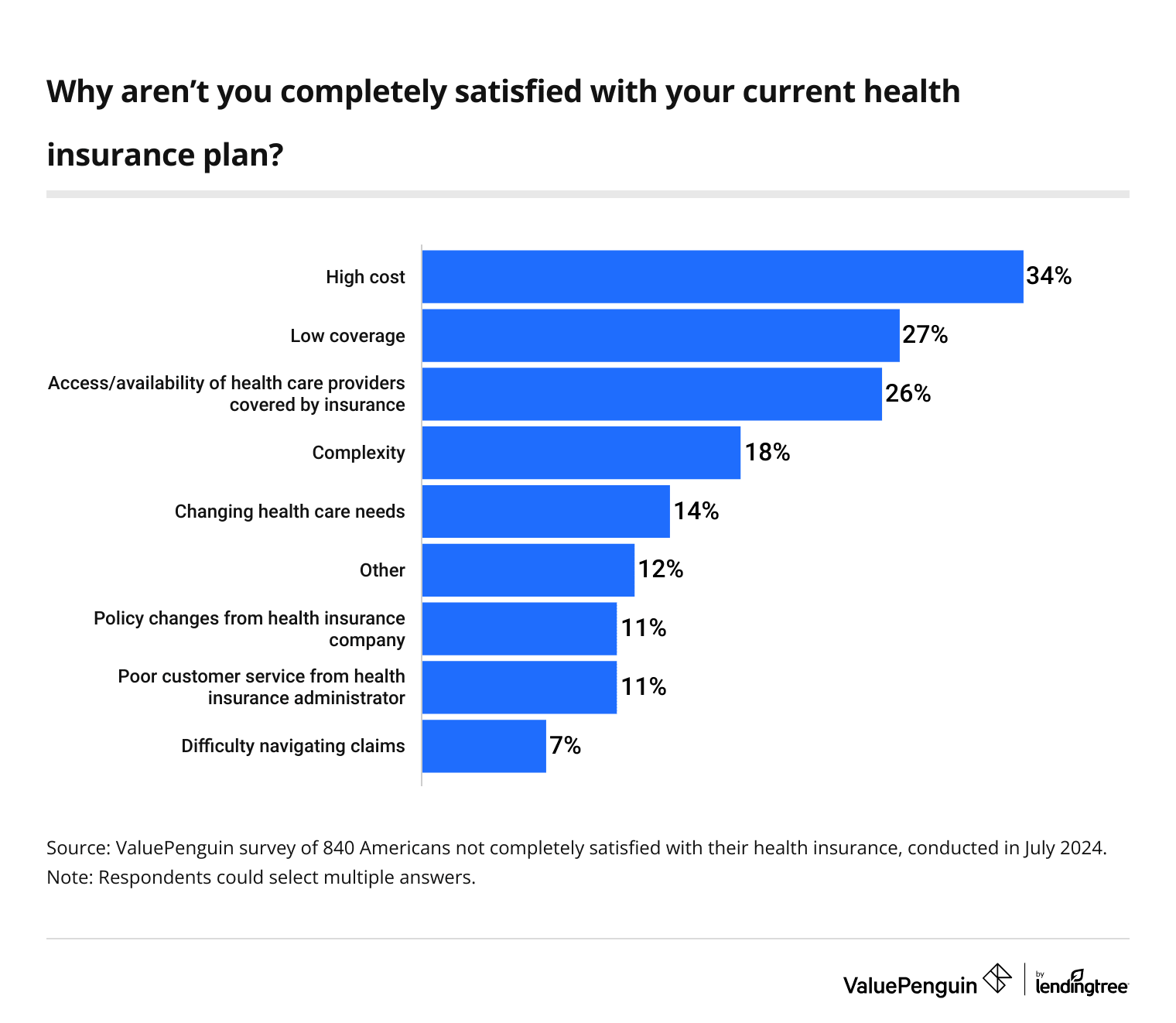Health Insurance
More Than 1 in 4 Insured Americans Considering Dropping Health Coverage

According to the Centers for Disease Control and Prevention (CDC), an estimated 27.1 million Americans didn’t have health insurance in the first quarter of 2024 — up 1.8 million from the first quarter of 2023.
But it doesn’t end there. According to the latest ValuePenguin survey of over 2,000 U.S. consumers, 27% of those currently insured are considering dropping their coverage this year or next.
Here’s what else we found.
On this page
Key findings
- While most Americans are content with their health insurance costs, some are considering dropping theirs. 87% of insured Americans say their health insurance is affordable, and 82% agree it saves them money. However, 27% of those currently insured have considered dropping their coverage this year or next.
- Many of those who’ve dropped insurance reinstated coverage quickly. Among the 20% of Americans who’ve dropped health insurance coverage, 73% reenrolled, with 62% of them doing so within six months. Additionally, 37% of Americans have considered insurance alternatives.
- High costs cause dissatisfaction among insured Americans. Among the 47% of insured Americans not fully satisfied with their current insurance, 34% blame high costs, 27% cite low coverage and 26% aren’t happy with access to covered providers. Many Americans fear for the future, with 72% worried about the rising cost of health care.
- Rising health care costs are a uniting issue among political parties. Republicans and Democrats agree health care is too expensive, at 82% and 81%, respectively. However, Republicans are more likely to blame the government (37%), while Democrats typically blame the insurance companies (38%).
Some Americans consider dropping their health insurance
Generally speaking, Americans are happy with their coverage. In fact, 87% of insured Americans say their health insurance is affordable.

Americans earning between $50,000 and $99,999 annually (18%), baby boomers ages 60 to 78 (16%), those with children 18 or older (16%) and independents (16%) are the most likely to say their health insurance premiums are unaffordable.
According to ValuePenguin health insurance expert Divya Sangameshwar, it’s understandable why Americans may temporarily forgo their insurance — but it’s a risky move.
"Health insurance costs are rising in 2024 and beyond," she says. "Saving a few thousand dollars by temporarily dropping health insurance can seem tempting since there are no longer tax penalties for going uninsured in 46 states. However, having no health insurance is incredibly risky for your health and finances. Uninsured Americans will ultimately spend a lot more money on their health care and face crippling medical debt, poor credit or even bankruptcy."
Meanwhile, 82% agree their health insurance saves them money, though a significant portion of independents (22%) and those making between $50,000 and $99,999 (21%) disagree.
With that in mind, 27% of those currently insured have considered dropping their coverage this year or next. That figure jumps to 49% among Gen Zers ages 18 to 27, with millennials ages 28 to 43 (40%), Americans with children younger than 18 (36%) and men (34%) following.
Those planning to drop their insurance may miss significant savings, as 79% of insured Americans report using their health insurance at least every few months. And 36% use their health insurance at least once every month.
Those who’ve dropped coverage likely to reinstate it
Dropping insurance may be a mistake, but Americans have been quick to recover. Overall, 20% of Americans have dropped health insurance coverage in the past, with those with children younger than 18 (27%), millennials (26%) and men (24%) the most likely to report this.
Of those who dropped insurance, 73% reenrolled. The majority did so quickly, with 62% getting back on insurance within six months.

Sangameshwar says most Americans who drop insurance coverage reenroll quickly when they discover how difficult it can be to get care as uninsured people.
"Contrary to what many Americans believe, outside of emergency departments, health providers aren’t required by law to provide medical services to individuals without insurance," she says. "Without insurance, every interaction with the health care system will have to be paid for entirely out of pocket — and those costs add up."
Additionally, 37% of Americans have considered insurance alternatives. Health discount cards (17%) and health cost-sharing plans (16%) are the most popular considerations.
Overall, 87% of Americans have some form of health insurance coverage. Gen Zers (19%), those without children (18%) and those making less than $35,000 (17%) are the most likely to be uninsured.
Insured Americans dislike high costs, low coverage and more
Despite many citing general affordability, 47% of insured Americans aren’t fully satisfied with their current insurance. Of this group, 34% blame high costs — the most popular reason for dissatisfaction. Following that, 27% cite low coverage and 26% aren’t happy with access to covered providers.

Meanwhile, 72% of Americans are worried about the rising cost of health care.
According to Sangameshwar, Americans are right to worry.
"Americans are already feeling the pinch," she says. "Medicines continue to become more expensive. The cost of private health insurance plans rose by 4% between 2023 and 2024, with several states seeing double-digit rate increases."
Employer-sponsored insurance — which is how most Americans get coverage — has also become 47% more expensive for families over the past decade, according to the Center for American Progress. And nearly 1 in 5 Americans turned to crowdfunding to pay for their own medical bills, sometimes despite having health insurance, according to a February 2024 ValuePenguin survey.
That’s not where the challenges end. In fact, 36% of Americans struggle to get health care appointments when they need them. This problem impacts younger Americans significantly more than their older counterparts. In fact, Gen Zers (47%) are far more likely to report difficulties getting health care appointments than their baby boomer (20%) counterparts.
Additionally, 52% of Americans worry about unexpected medical bills. Those making between $50,000 and $99,999 (58%), parents with young children (58%), Democrats (55%) and Gen Xers ages 44 to 59 (55%) are the most worried about this.
Rising health care costs concern most Americans
High costs affect almost everyone. Overall, 81% of Americans think health care is generally too expensive, with Republicans (82%) and Democrats (81%) agreeing.
Americans who think it’s too expensive are most likely to blame the government (35%). That’s followed by:
- Insurance companies (31%)
- Pharmaceutical companies (13%)
- Hospitals (11%)
- Health care workers (7%)
Notably, Republicans are more likely to blame the government (37%), while Democrats are more likely to blame the insurance companies (38%).
Switching or forgoing health insurance? Top expert tips
Before you drop your health insurance coverage, Sangameshwar says you need to look closely at your finances to see if you can afford it. A good first step is to call your providers, such as your primary care physician, urgent care or emergency room, to find out how much a visit will cost without insurance.
"Going without health insurance is very high risk," she says. "If you’re struggling to afford your insurance, you can opt for a cheaper, higher deductible plan, or even alternatives like a short-term insurance plan or health-sharing plan. While these plans don’t offer the kind of coverage you may get with a higher cost plan, they can provide you with basic health care."
If you drop your insurance and find yourself with a huge medical bill, here are tips from Sangameshwar to manage those expenses:
- Try negotiating costs on your own. Comb through your medical bills and spot any charges that seem wrong or too high, then be persistent in following up with customer service representatives for an explanation. If you have a medical bill in collections, you can negotiate down the money you owe. Debt collectors generally buy debts for pennies on the dollar, giving you leverage to negotiate to pay less than owed.
- Work with a medical advocate. A medical bill advocate knows how to read health care bills. They can also spot potential billing errors and overcharges, helping you reduce your debt. However, do your research before choosing a billing advocate to avoid being scammed. It also doesn’t make sense to hire a medical advocate if their fees are higher than the amount you owe.
- Set up a payment plan. Many medical providers can work out a no- or low-interest payment plan for your medical bills, a simple way to resolve a bill you can’t afford in one payment. You can break the bill into multiple equal payments over a few months until the total is covered. Before taking this option, however, check into billing charges or other fees associated with the payment plan to assess the affordability.
- Check if you qualify for an income-driven hardship plan. Lower-income Americans with large medical bills can be eligible for an income-driven hardship repayment plan. While these may be like a normal repayment plan, an income-driven hardship plan will break up the total amount owed into more manageable, regular repayments, or even forgive part of the debt or the entire debt. Nonprofit hospitals generally offer some form of charity care.
Methodology
ValuePenguin commissioned QuestionPro to conduct an online survey of 2,030 U.S. consumers ages 18 to 78 from July 15 to 17, 2024. The survey was administered using a nonprobability-based sample, and quotas were used to ensure the sample base represented the overall population. Researchers reviewed all responses for quality control.
We defined generations as the following ages in 2024:
- Generation Z: 18 to 27
- Millennial: 28 to 43
- Generation X: 44 to 59
- Baby boomer: 60 to 78